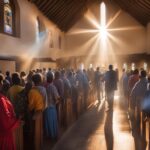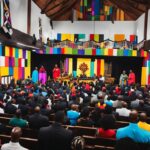Prayer in church is a profound spiritual practice that holds tremendous significance for individuals and communities. It serves as a gateway to connect with a higher power, fostering a deeper sense of faith and spiritual growth. In this article, we will journey through the transformative power of prayer in the church, exploring its history, beliefs, rituals, leadership, worship practices, sacred texts, denominations, community outreach, architectural features, and contemporary challenges. Through this exploration, we hope to provide insights into the power and beauty of prayer and its impact on personal and communal faith journeys.
Key Takeaways:
- Prayer in church is a fundamental aspect of the spiritual experience, connecting individuals with a higher power.
- It fosters a sense of community and spiritual growth within the church.
- The history and origins of prayer in church can be traced back to the early days of Christianity.
- Beliefs and doctrines shape the role and significance of prayer in the spiritual life of believers.
- Prayer in church is often intertwined with sacred rituals and sacraments, deepening the spiritual experience.
History and Origins of Prayer in Church
Prayer in church has a long and profound history that can be traced back to the early days of Christianity. Its origins lie in the teachings of Jesus and the practices of the first Christian communities. Jesus himself set an example of prayer, emphasizing its importance in connecting with God and seeking divine guidance. In the early church, prayer served as a means of worship, spiritual growth, and communal bonding.
The practice of prayer in church began as believers gathered together to pray, share their faith, and support one another. These gatherings often took place in homes or other private spaces, providing a sacred environment for prayer and worship. As the Christian movement grew, prayer became an integral part of formal worship services and public gatherings.
Over time, various traditions and rituals surrounding prayer developed, influenced by cultural, geographical, and theological factors. Different church denominations adopted distinct prayer practices, reflecting their beliefs, values, and historical contexts. These traditions and rituals continue to shape the way prayer is practiced in churches today, adding depth and richness to the spiritual experience.
“Prayer is not asking. It is a longing of the soul. It is daily admission of one’s weakness. It is better in prayer to have a heart without words than words without a heart.” – Mahatma Gandhi
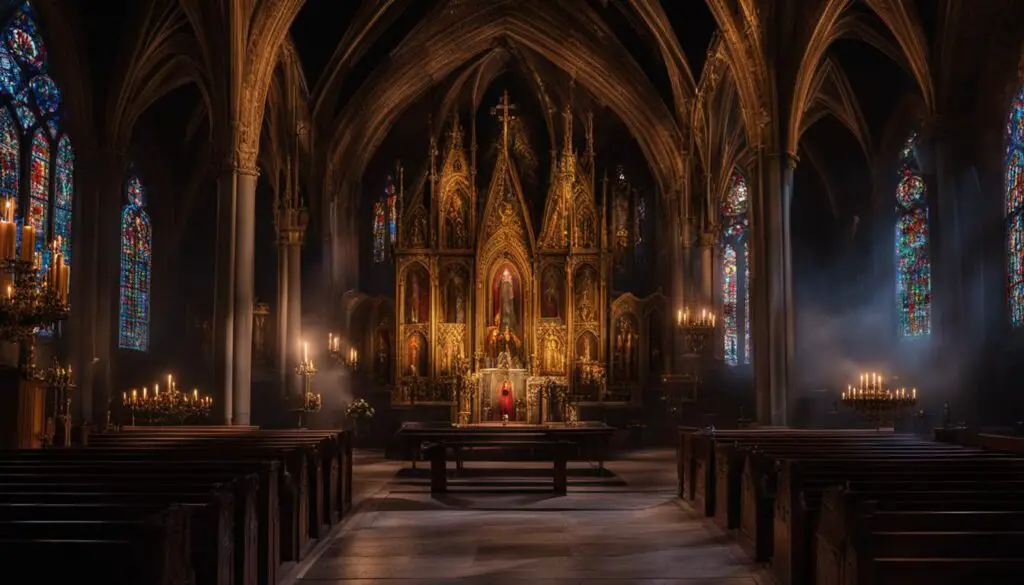
Significance of Prayer in Church
Prayer holds great significance in the life of the church and its members. It serves as a powerful tool for strengthening faith, seeking divine guidance, finding solace, expressing gratitude, and building a sense of community. Through prayer, individuals and congregations deepen their relationship with God, experience spiritual transformation, and draw closer to one another.
Prayer in church not only fosters personal spiritual growth but also enables collective worship and intercession for the needs of the community. It brings people together, creating a sense of unity and shared purpose. Prayer in church gatherings cultivates an atmosphere of reverence, humility, and awe before the Divine, allowing for deeper connections with the sacred.
Moreover, prayer in church serves as a source of comfort and hope during challenging times. It provides a space for individuals to pour out their hearts, find solace in God’s presence, and seek strength and healing. Prayer in the church community reinforces a sense of support, love, and shared burdens, as believers come together to lift one another up in prayer.
Overall, prayer in church is a vital practice that shapes the spiritual life of believers, strengthens community bonds, and brings individuals closer to the Divine.
Beliefs and Doctrines Related to Prayer in Church
Prayer in church is not simply a routine or a formality, but a deeply spiritual practice rooted in specific beliefs and doctrines. These beliefs and doctrines shape the role and significance of prayer in the life of believers, providing a theological foundation for this sacred act.
Churches hold diverse beliefs about prayer, with variations across different denominations and theological perspectives. However, there are certain fundamental principles that underpin the understanding of prayer in church.
1. Communication with God
One of the core beliefs about prayer in church is that it serves as a means of communication with God. Through prayer, individuals express their thoughts, emotions, and desires to a divine being. It is seen as an avenue for establishing a personal and intimate relationship with God, seeking guidance, and offering gratitude.
2. Intercession and Divine Intervention
Prayer in church often involves intercession, which is the act of praying on behalf of others. Believers approach God with their requests, seeking divine intervention and assistance for themselves and the wider community. It is believed that through prayer, God’s power and grace can bring about positive change and address the needs of individuals and society.
3. Reverence and Surrender
In the context of prayer in church, there is an emphasis on approaching God with reverence and surrender. Believers acknowledge God’s sovereignty and authority, recognizing their own limitations and dependence on Him. Prayer is seen as an act of humility and surrender, where individuals place their trust in God’s wisdom and submit to His will.
4. Alignment with God’s Word
Churches often emphasize the importance of aligning prayers with God’s Word, which is typically seen as the ultimate source of divine instruction and revelation. The doctrines of prayer in church highlight the significance of praying in accordance with biblical principles and seeking God’s guidance through Scripture. This ensures that prayers are grounded in truth and reflect God’s will.
These beliefs and doctrines related to prayer in church shape the way it is practiced and understood within different faith communities. They provide a theological framework that adds depth and spiritual significance to the act of prayer.

Sacraments and Rituals Associated with Prayer in Church
Prayer in church is a deeply spiritual experience that is often accompanied by sacred rituals and sacraments. These practices hold immense significance and provide believers with profound opportunities for connecting with God and strengthening their faith.
One of the central sacraments associated with prayer in the church is the Eucharist (also known as Holy Communion or the Lord’s Supper). This sacrament involves the sharing of bread and wine, symbolizing the body and blood of Christ, and serves as a powerful moment of communion with both God and fellow believers. Through the Eucharist, individuals partake in a sacred act of remembrance and thanksgiving, deepening their connection to the divine.
Another significant sacrament closely tied to prayer is baptism. Baptism represents a symbolic cleansing and rebirth, marking the initiation of an individual into the church community. Through the act of baptism, believers publicly express their commitment to following Christ and seek God’s grace and blessings. Baptism serves as a meaningful ritual that embodies the believer’s prayerful journey towards a new life in Christ.
In addition to these sacraments, various rituals accompany prayer in the church. These rituals often vary across different denominations and traditions, but they all share the common goal of deepening the spiritual connection between individuals and God.
Examples of rituals associated with prayer in church:
- Prayer of confession: A time of repentance and seeking forgiveness for sins.
- Liturgy of the hours: A structured format for praying at specific times of the day.
- Anointing with oil: A practice of laying hands and praying for physical, emotional, or spiritual healing.
- Confirmation: A sacramental rite where individuals affirm their faith and receive the Holy Spirit.
- Prayer for the departed: A remembrance and intercession for those who have passed away.
These rituals, along with sacraments, serve as powerful vehicles for prayer in the church, creating moments of transformation, renewal, and spiritual growth for believers.
Baptismal Font and Eucharistic Table
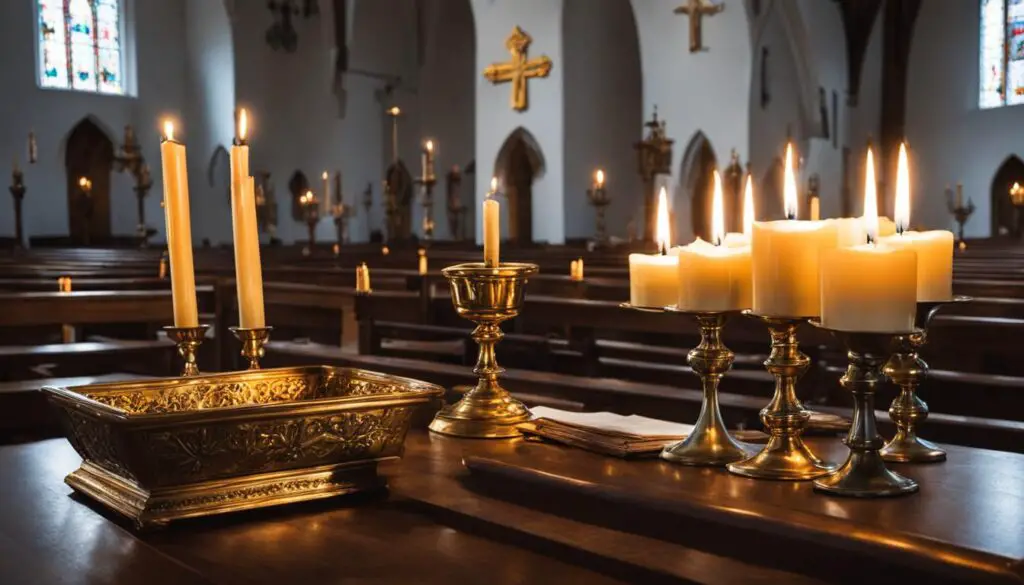
| Sacraments and Rituals | Meaning and Purpose |
|---|---|
| Eucharist | Symbolizes communion with God and fellow believers through the sharing of bread and wine. |
| Baptism | Represents a symbolic cleansing and rebirth, marking an individual’s initiation into the church community. |
| Prayer of Confession | Provides a space for repentance and seeking forgiveness for sins. |
| Liturgy of the Hours | Facilitates structured prayer at specific times of the day, fostering a rhythm of worship and devotion. |
| Anointing with oil | Involves laying hands and praying for healing, whether physical, emotional, or spiritual. |
| Confirmation | Confirms and affirms an individual’s faith, allowing them to receive the Holy Spirit. |
| Prayer for the Departed | Remembrance and intercession for those who have passed away. |
Leadership and Clergy’s Role in Facilitating Prayer in Church
Leadership and clergy play a vital role in facilitating and guiding prayer within the church. Their dedication and commitment to nurturing the spiritual lives of believers create a vibrant culture of prayer within the congregation.
The clergy, including pastors, priests, and ministers, lead prayer services, creating sacred spaces where the community can gather and connect with the divine. With their profound knowledge of religious traditions and scriptures, they offer spiritual guidance and provide opportunities for believers to deepen their connection with God.
“The role of the clergy is to shepherd the flock, guiding them on their faith journey and showing them the path of prayer,” says Reverend Emma Johnson, a renowned church leader and theologian.
In addition to leading prayer services, clergy members are actively involved in pastoral care, providing comfort and support to individuals and families in times of need. They offer solace and guidance through prayer, helping believers find strength and resilience in their spiritual lives. “Clergy play a significant role in offering prayerful guidance and comfort to those seeking healing and guidance,” explains Reverend Johnson.
Moreover, clergy members often organize prayer gatherings and events, fostering a sense of community and unity among the congregation. These gatherings allow believers to come together, share their joys and sorrows, and lift each other up through prayer. The clergy’s leadership in these events deepens the sense of community and emphasizes the importance of prayer within the church.
The clergy’s role in facilitating prayer extends beyond the walls of the church. They engage in outreach initiatives, coordinating prayer vigils and intercessory prayer sessions for the local community and global causes. By actively involving the congregation in prayers for social issues and justice, clergy members empower believers to make a positive impact on the world.
In summary, leadership and the clergy play a central role in facilitating prayer in the church. Through their guidance, pastoral care, and commitment to fostering a culture of prayer, they provide invaluable support to believers on their spiritual journeys. Their influence extends beyond the church walls, empowering the community to engage in prayerful outreach and make a meaningful difference in the world.
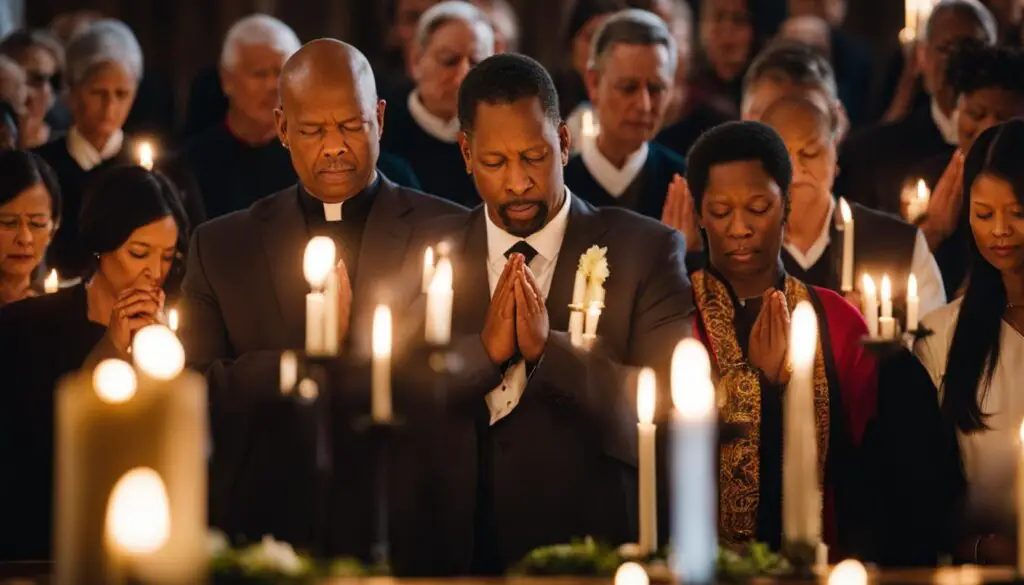
Worship Practices Incorporating Prayer in Church Services
Prayer is a foundational element of church worship, infusing every aspect of the worship experience with reverence, thanksgiving, and supplication. From the first moments of a service to the closing benediction, prayers play a vital role in connecting individuals with God and fostering a sense of unity and devotion within the congregation.
At the beginning of church services, opening prayers serve as an invitation for God’s presence to dwell among the worshippers. These heartfelt petitions set the tone for the rest of the worship, creating an atmosphere of reverence and anticipation. They express gratitude for the opportunity to gather, seek divine guidance, and invoke God’s blessings over the congregation.
Throughout the worship service, intercessory prayers provide an opportunity for the congregation to unite in seeking God’s intervention and intervention on behalf of others. This form of prayer demonstrates the church’s commitment to love and care for one another, as well as its desire to make a positive impact in the world. Intercessory prayers may encompass a wide range of concerns, including the welfare of the church, community, nation, and global issues.
Prayers of thanksgiving are another integral component of church worship, allowing believers to express gratitude for God’s faithfulness, provision, and grace. Whether giving thanks for answered prayers, blessings received, or simply acknowledging God’s goodness, these prayers cultivate a spirit of gratitude and humility.
“In worship, we enter the divine presence with prayerful hearts, acknowledging our utter dependence on God and embracing the transformative power of His love.”
Individual and spontaneous prayers also find a place within church worship, providing opportunities for personal connection with God. Some churches incorporate a time of silence or offer designated moments for individuals to lift up their prayers silently or aloud. These intimate moments of communion with the divine allow worshippers to express their deepest thoughts, struggles, and desires, finding solace in the knowledge that God hears every word spoken and unspoken.
The integration of prayer into worship services creates a dynamic and meaningful experience for the congregation, fostering spiritual growth and deepening their connection with God and one another. Through the act of prayer, individuals and the church as a whole can experience renewal, guidance, healing, and a deepening of their relationship with the divine.
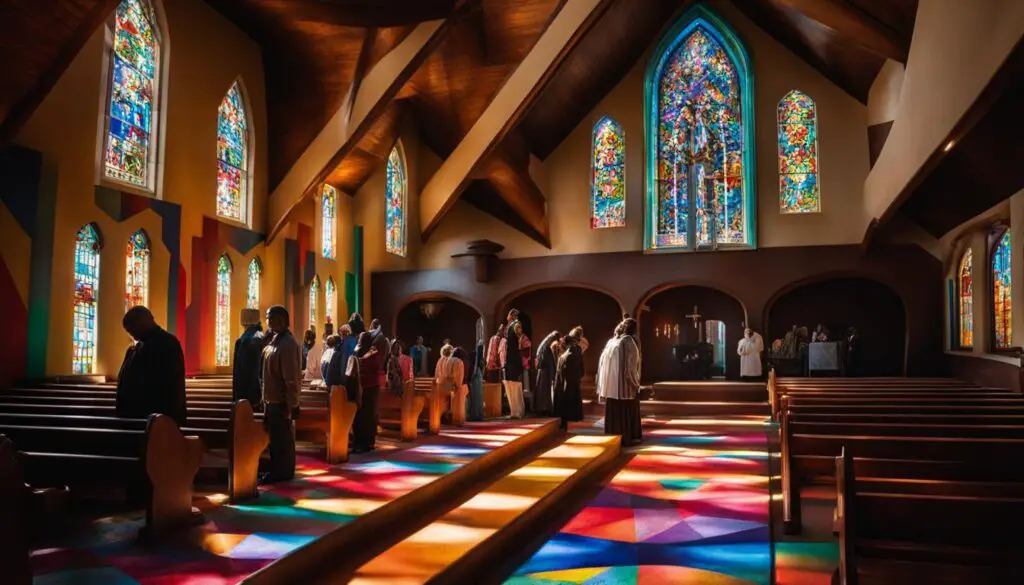
| Types of Prayers | Description |
|---|---|
| Opening Prayers | Invitation for God’s presence; setting the tone for worship |
| Intercessory Prayers | Seeking God’s intervention for individuals, community, and world |
| Prayers of Thanksgiving | Expressing gratitude for God’s faithfulness, provision, and grace |
| Individual and Spontaneous Prayers | Personal communion with God; expressing personal thoughts and desires |
Sacred Texts and their Role in Prayer in Church
Sacred texts, such as the Bible, hold a central place in prayer within the church. Prayers often draw from the wisdom and teachings found in these texts, providing a spiritual foundation and guidance for believers. The Bible serves as a source of inspiration, offering prayers that resonate with the human experience and address various facets of life’s challenges and joys.
Scripture-based prayers offer believers a language and structure to express their thoughts, emotions, and needs in communion with God. They provide a framework for personal reflection, intercession for others, and expressions of thanksgiving and praise. By incorporating scripture into their prayers, individuals connect their words to the divine revelations contained in the sacred texts, seeking to align their hearts and minds with God’s will.
“Let the words of my mouth and the meditation of my heart be acceptable in your sight, O Lord, my rock and my redeemer.” – Psalm 19:14
The Bible contains a wealth of prayers that cover a wide range of human experiences, emotions, and spiritual aspirations. From the Psalms’ poetic expressions of devotion and lament to the fervent supplications of the prophets and the heartfelt prayers of Jesus and the apostles, scripture-based prayers serve as timeless expressions of faith, guiding and shaping the prayers of believers throughout history.
By engaging with sacred texts through prayer, individuals deepen their understanding of God’s character and His loving and redemptive work in the world. The scriptures provide a framework for spiritual growth, offering believers guidance, comfort, and transformative insights. Biblical prayers not only connect individuals with God but also foster a sense of unity and continuity within the broader faith community.
“Your word is a lamp to my feet and a light to my path.” – Psalm 119:105
As believers turn to the Bible in their prayerful devotion, they encounter narratives of God’s faithfulness, promises of divine guidance, and teachings on how to live a righteous and compassionate life. Through scripture-based prayers, individuals open themselves to the transformative power of God’s word, seeking His wisdom and grace to shape their lives according to His will.
| Key Role of Sacred Texts in Prayer in Church | Bible Verses |
|---|---|
| Foundation for Prayer | 2 Timothy 3:16-17 – “All Scripture is breathed out by God and profitable for teaching, for reproof, for correction, and for training in righteousness, that the man of God may be complete, equipped for every good work.” |
| Inspiration for Personal Devotion | Psalm 119:11 – “I have stored up your word in my heart, that I might not sin against you.” |
| Guide for Intercession | 1 Timothy 2:1-2 – “First of all, then, I urge that supplications, prayers, intercessions, and thanksgivings be made for all people, for kings and all who are in high positions, that we may lead a peaceful and quiet life, godly and dignified in every way.” |
| Expression of Worship and Praise | Psalm 150:6 – “Let everything that has breath praise the LORD! Praise the LORD!” |
Denominations and Sects’ Approaches to Prayer in Church
Prayer in church takes on different forms and practices across various denominations and sects. Each group brings its unique traditions and beliefs, enriching the spiritual experience of its members. Exploring the diversity of prayer practices in different church communities offers a broader perspective on how prayer is understood and celebrated within the larger Christian tapestry.
Denominations like the Roman Catholic Church often incorporate elaborate liturgical prayer, drawing from ancient rituals and sacraments. The use of icons and statues, along with recitations of scripted prayers, fosters a sense of reverence and awe in their worship. Catholic Masses include prayers of adoration, confession, thanksgiving, and supplication, led by clergy within ornate sanctuaries.
On the other hand, Protestant denominations, such as the Methodist Church, place a stronger emphasis on extemporaneous, spontaneous prayers. Congregants are encouraged to pray from the heart, expressing their personal relationship with God in a more intimate and personal manner. These churches value the individual’s direct communication with God and often incorporate moments of silent reflection and prayer during their services.
In the charismatic tradition, sects like the Pentecostal Church place great importance on the practice of prayer through spiritual gifts, such as speaking in tongues or prophetic utterances. These expressive and vibrant forms of prayer are seen as a direct connection between the believer and the Holy Spirit, allowing for a deep spiritual encounter. Charismatic churches often have extended times of passionate and exuberant worship, with fervent prayers and songs of praise.
“Our prayers may be heard in different ways, but our faith unifies us in our pursuit of a closer relationship with God.”
Other sects, like the Quakers, embrace a contemplative and quiet approach to prayer. Their worship services often involve sitting silently in communal prayer, waiting for the inner promptings of the Holy Spirit to guide their thoughts and actions. This meditative form of prayer creates space for reflection, introspection, and communal discernment.
The diversity of prayer practices in different church denominations and sects reflects the richness of the Christian faith and the profound ways in which individuals connect with the divine. Despite the variations, the common thread among these traditions is the desire to seek spiritual communion, draw closer to God, and find solace and guidance through prayer.
| Denomination/Sect | Approach to Prayer |
|---|---|
| Roman Catholic Church | Elaborate liturgical prayers, recitations, and sacraments |
| Methodist Church | Spontaneous prayers, emphasis on personal communication with God |
| Pentecostal Church | Charismatic expressions, spiritual gifts, fervent prayers |
| Quakers | Contemplative and quiet prayer, waiting on the Holy Spirit |
Key Takeaways:
- Prayer practices vary across different church denominations and sects.
- The Roman Catholic Church emphasizes elaborate liturgical prayers and sacraments.
- Protestant denominations often encourage spontaneous, heartfelt prayers.
- Charismatic sects value expressive forms of prayer through spiritual gifts.
- Quakers embrace a contemplative and quiet approach to prayer.
By appreciating the variety of prayer practices, we can deepen our understanding of the diverse ways in which individuals and communities connect with God, fostering unity amidst theological differences.
Community Engagement and Outreach through Prayer in Church
Prayer in church extends beyond the walls of the building, serving as a catalyst for community engagement and outreach. It is through the power of prayer that churches can make a positive impact on society and address the various needs of their communities.
The church’s role in the community through prayer is multi-faceted. Firstly, prayer serves as a means of outreach, allowing churches to connect with individuals and organizations in need. By gathering in prayer, churches can identify the pressing social issues that require attention, such as poverty, homelessness, or injustice. Through prayer, churches can unite their members and mobilize them to take action, providing support and assistance to those in need.
Moreover, prayer as a means of outreach is not limited to material assistance but also extends to emotional and spiritual support. By offering prayers for healing, comfort, and guidance, churches can provide solace to those facing difficult circumstances. Prayer creates a sense of community and solidarity, reminding individuals that they are not alone in their struggles.
“Prayer is not asking. It is a longing of the soul. It is daily admission of one’s weakness. It is better in prayer to have a heart without words than words without a heart.” – Mahatma Gandhi
Additionally, prayer in church allows for advocacy and speaking out against injustice. By coming together in prayer, churches can raise awareness about issues of inequality and discrimination. Through prayer gatherings, churches can emphasize the importance of compassion, justice, and equality, inspiring their members to actively engage in efforts to bring about positive change.
Furthermore, the church’s role in the community through prayer extends to fostering reconciliation and peace. Churches can organize interfaith prayer gatherings to promote understanding, acceptance, and unity among different religious groups. By promoting dialogue and prayerful interactions, churches can contribute to building a more harmonious and inclusive community.
Through prayer, churches can actively engage with their communities, addressing their needs, and promoting positive social transformation. By organizing prayer initiatives, partnering with local organizations, and advocating for justice and compassion, churches can make a profound impact on society.
Examples of Community Engagement through Prayer
Here are a few examples of how churches have utilized prayer as a means of community engagement and outreach:
- Organizing prayer walks through local neighborhoods to foster relationships with residents and pray for their specific needs.
- Creating prayer ministries that focus on supporting marginalized and vulnerable populations, such as the homeless, refugees, or those struggling with addiction.
- Establishing prayer chains or prayer hotlines to receive requests for prayer and provide emotional and spiritual support.
- Partnering with local schools to offer prayer groups for students, teachers, and parents, addressing the challenges they face and fostering a supportive educational environment.
- Hosting prayer vigils or gatherings in response to tragedies or acts of violence, offering comfort, healing, and prayers for peace.
The Transformative Power of Prayer
It is through prayer that churches can embody their faith and make a tangible difference in the lives of individuals and communities. Prayer equips believers with the strength, wisdom, and compassion to actively engage in the world around them, advocating for justice, supporting those in need, and fostering a sense of belonging and community.
Next, we will explore another crucial aspect of prayer in church – the architectural and artistic features that reflect and enhance the prayer experience, creating sacred spaces that inspire and uplift.
Architectural and Artistic Features Reflecting Prayer in Church
When you step into a church, you are greeted by a symphony of architectural and artistic expressions that evoke a sense of reverence and spiritual connection. From the towering spires that reach towards the heavens to the intricate stained glass windows that bathe the interior in a kaleidoscope of colors, every element of the church’s design is imbued with symbolism and intention.
One of the most striking features of a church is its stained glass windows. These windows serve as both visual narratives and portals to the divine. They depict scenes from religious mythology, biblical stories, and the lives of saints, inviting worshippers to enter into these sacred narratives through contemplation and prayer. The play of light filtering through the vibrant colors of the glass creates an ethereal ambiance, enveloping the space in a sense of awe and wonder.
Architecture also plays a crucial role in shaping the prayer experience. The soaring arches and vaulted ceilings create a sense of expansiveness, symbolizing the transcendence of the divine. The intentional use of specific architectural styles, such as Gothic or Byzantine, further enhances the spiritual atmosphere. These styles evoke a sense of timelessness and connection to centuries of prayer and worship, reminding worshippers of their place within the larger tapestry of Christian history.
Furthermore, the layout of the church and the arrangement of its spaces contribute to the experience of prayer. The altar, positioned at the heart of the church, serves as the focal point for worshippers to direct their prayers and attention. The presence of chapels and prayer nooks throughout the church allows for moments of individual contemplation and intimate prayer. Every corner of the church is meticulously designed to create an environment conducive to deepening one’s connection with the divine.
FAQ
What is the significance of prayer in church?
Prayer in church is a fundamental aspect of the church experience, connecting individuals with a higher power and fostering a sense of community and spiritual growth. It serves as a way to communicate with God and seek guidance, strength, and comfort.
How did prayer in church originate?
Prayer in church has a rich history that dates back to the early days of Christianity. It finds its roots in the teachings of Jesus and the practices of the early church. Over time, various traditions and rituals surrounding prayer have emerged, shaping the way prayer is practiced in different church denominations.
What beliefs and doctrines are related to prayer in church?
Beliefs and doctrines related to prayer in church may vary across different church denominations and theological perspectives. However, common themes include the belief in the power of prayer, the importance of seeking God’s will, and the belief that prayers are heard and answered by God according to His divine plan.
What sacraments and rituals are associated with prayer in church?
Prayer in church is often intertwined with sacred rituals and sacraments that hold deep spiritual and symbolic significance. These include the Eucharist (Holy Communion), baptism, confirmation, and anointing of the sick. These rituals provide opportunities for communal prayer and connection with God.
What role do church leaders play in facilitating prayer?
Within the church, clergy and church leaders play a crucial role in facilitating and guiding prayer. They lead prayer services, provide pastoral care, and offer spiritual guidance to the community. Their role is to foster a culture of prayer and nurture the spiritual lives of believers.
How is prayer incorporated into church worship services?
Prayer is an integral part of church worship services, with prayers being incorporated into various elements of the worship experience. From opening prayers to intercessory prayers and prayers of thanksgiving, worship practices in the church provide a space for communal and individual prayer.
How are sacred texts involved in prayer in church?
Sacred texts, such as the Bible, hold a central place in prayer within the church. Prayers often draw from the wisdom and teachings found in these texts, providing a spiritual foundation and guidance for believers. The Bible is seen as the inspired Word of God and serves as a source of inspiration for prayers.
Do different church denominations have different approaches to prayer?
Yes, different church denominations and sects may have distinct approaches to prayer, incorporating unique traditions and practices. These may include specific prayer formats, liturgical prayers, or emphasis on personal prayer. Understanding the diversity of prayer practices across denominations offers a broader perspective on how prayer is understood and practiced within the larger Christian community.
How does prayer in church extend beyond the church walls?
Prayer in church extends beyond the walls of the building, serving as a catalyst for community engagement and outreach. Churches often come together in prayer to address social issues, provide support to those in need, and advocate for justice and compassion. Prayer becomes a means of expressing love and care for others in the community.
How do the architectural and artistic features of a church reflect prayer?
The physical design and artistic elements of a church often reflect and enhance the experience of prayer. Stained glass windows depicting religious scenes, architectural features that create a sense of sacred space, and symbols and artwork related to prayer all contribute to the visual and spiritual dimensions of prayer within the church.










